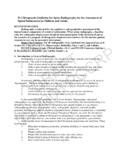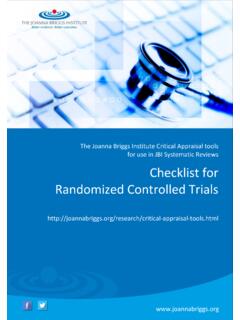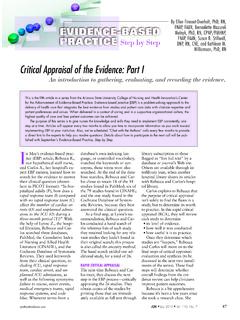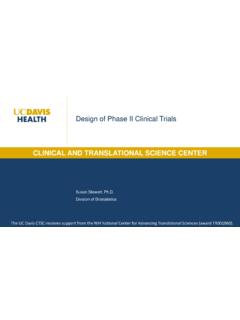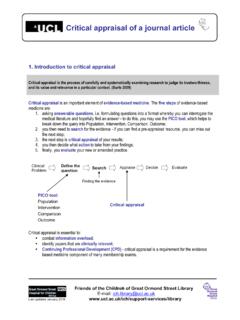Transcription of I. Description of Levels of Evidence, Grades and ... - PCCRP
1 DRAFT(c) 2006 PCCRPI. Description of Levels of Evidence, Grades and Recommendations Introduction Recently, the buzzwords evidence-based, evidence-based medicine (EBM), and evidence-based practice (EBP) have appeared in clinical practice protocols. EBP is defined as clinical decision-making based on (1), sound external research evidence combined with individual clinical expertise and (2), the needs of the individual ,2 (emphasis added) The goal of EBP is to improve patient outcomes, quality of care, and provide some standardization of treatment. EBP protocols have recently been written for several One of the issues being debated is what does and what does not provide evidence in Understanding the relevance and weight of evidence is an important topic when creating evidence based guidelines.
2 The current guidelines seek to draw on the research and evidence in relation to the chiropractic utilisation of x-rays. Hence while some considerations will be to look at general evidence from across the health care and radiation science spectrum, specific evidence in relationship to chiropractic x-ray utilisation will be a primary consideration. When reviewing a volume of evidence on a particular topic, it is importance to understand there are different Levels of evidence, that not all forms of evidence can be considered of equal value. However, of equal importance, it also needs to be stated that all Levels of evidence are important and have their respective value.
3 It is widely accepted in the scientific and health care community that there are four Levels of clinical treatment evidence. Depending on which organisation s guideline we look at, there are subtle variations however the basic categorisations are the same: Level 1. randomized controlled trials includes quasi- randomized processes such as alternate allocation. Level 2. Non- randomized controlled trial a prospective (pre-planned) study, with predetermined eligibility criteria and outcome measures. Level 3. Observational studies with controls includes retrospective, interrupted time series (a change in trend attributable to the intervention), case-control studies, cohort studies with controls, and health services research that includes adjustment for likely confounding variables.
4 Level 4. Observational studies without controls ( , cohort studies without controls, case series without controls, and case studies without controls) (Source: the United States Department of Health and Human services ) Or Level I: randomized controlled trials. This is generally accepted as the most reliable evidence of whether a treatment is effective. Level II (a): Good studies with a non- randomized control group (case/control or cohort). Prospective data or case notes, similar groups, correcting for confounding in the analysis, Level II (b): Poor studies with a non- randomized control group (case/control or cohort).
5 Data gathered after the event, poorly matched groups, no attempt to correct for confounding Level III: Studies with no control group. Case series, anecdote, and testimonial. DRAFT(c) 2006 PCCRP (Source: Department of Public Health Sciences King's College London ) Or Level I: Evidence obtained from at least one properly designed randomized controlled trial. Level II-1: Evidence obtained from well-designed controlled trials without randomization. Level II-2: Evidence obtained from well-designed cohort or case-control analytic studies, preferably from more than one centre or research group.
6 Level II-3: Evidence obtained from multiple time series with or without the intervention. Dramatic results in uncontrolled trials could also be regarded as this type of evidence. Level III: Opinions of respected authorities, based on clinical experience, descriptive studies, or reports of expert committees. Discussion When we consider the evidence from the chiropractic field we can not exclusively or even primarily restrict evidence to RCTs. As chiropractic is a clinical based science with few allied industries willing to invest into research, as pharmaceutical companies do in medicine.
7 The most prevalent type of research in chiropractic is non- randomized clinical trials, case series, and case studies. The highest of these have control groups and there are a select few that also have randomized control groups. The main reasons for lack of RCTs in chiropractic research include labour intensiveness, cost, usually restricted to university research groups, and in the chiropractic field, there is not the tradition of research at a university level as there is in other health sciences. In order to create a guideline that is truly evidenced based but still relevant to the chiropractic profession, all Levels of evidence need to be considered.
8 In some cases, chiropractic guideline developers have excluded specific types or Levels of evidence for unknown In 2001, Bolton1 discussed the reliance on RCT s in EBP protocols. Although the first few published RCTs on spinal manipulative therapy (SMT) were important for the chiropractic profession, RCTs are many times narrow in methodology as to not be useful in clinical chiropractic ,14 Although the RCT is unarguably the best research design for investigating a specific intervention compared to a known intervention or a placebo, randomization and controlled conditions play no part in everyday clinical practice 1 and thus, evidence for effectiveness in that arena cannot be solely collected by RCTs.
9 The strengths and limitations of the RCT have been discussed Given the limitations of the RCT in evaluating chiropractic treatment,14 it has been stated that it does not make sense to exclusively pursue the RCT in the Other research designs such as qualitative and outcomes research are now being recognized as very meaningful ways of providing the evidence in Additionally, it is known today that well-done case studies most often demonstrate findings consistent with that of the For examples: 1. Benson and Hartz18 stated, We found little evidence that estimates of treatment effects in observational studies reported after 1984 are either consistently larger than or qualitatively different from those obtained in randomized , controlled trials.
10 And 2. Rosner19 stated, From this discussion, it is apparent that a well crafted cohort study or case series may be of greater informative value than a flawed or corrupted RCT. And, DRAFT(c) 2006 PCCRP3. Concato et al20 stated, The results of well-designed observational studies (with either a cohort or a case-control design) do not systematically overestimate the magnitude of the effects of treatment as compared with those in randomized , controlled trials on the same topic. And, The popular belief that only randomized , controlled trials produce trustworthy results and that all observational studies are misleading does a disservice to patient care, clinical investigation, and the education of health care professionals.
